Mystrium rogeri
| Mystrium rogeri | |
|---|---|

| |
| Scientific classification | |
| Kingdom: | Animalia |
| Phylum: | Arthropoda |
| Class: | Insecta |
| Order: | Hymenoptera |
| Family: | Formicidae |
| Subfamily: | Amblyoponinae |
| Tribe: | Amblyoponini |
| Genus: | Mystrium |
| Species group: | mysticum |
| Species: | M. rogeri |
| Binomial name | |
| Mystrium rogeri Forel, 1899 | |
Mystrium are predators that specialize on large centipedes. Mystrium rogeri colonies have a single dealate queen and average 94 workers. Nests are found in rotten logs (Molet et al. 2007).
Photo Gallery
Identification
The females of Mystrium rogeri can be distinguished easily from other Mystrium females by the combination of a distinct longitudinal carina on the central portion of the labrum or a single lateral spine on abdominal sternum VII, and the straight anterior margin of the clypeus. In addition to these diagnostic characters, a combination of unsculptured and smooth areas on the ventral portion of the vertex and the straight anterior clypeal margin separates Mystrium rogeri from the other Mystrium species workers; and a larger-sized alate queen (HW>1.99) with spatulate setae on the pronotal dorsum separate M. rogeri from the queens of other species. For males, the small eye and small ocelli that are separated from each other by a distance of more than 3 × the maximum diameter of lateral ocellus, petiolar dorsum and abdominal tergum VIII with rough and deep punctures, and less developed basoventral expansion of aedeagus separate M. rogeri from the other Mystrium males in the Malagasy region. (Yoshimura and Fisher 2014)
Keys including this Species
Distribution
Latitudinal Distribution Pattern
Latitudinal Range: -12.26278° to -25.08767°.
| North Temperate |
North Subtropical |
Tropical | South Subtropical |
South Temperate |
- Source: AntMaps
Distribution based on Regional Taxon Lists
Afrotropical Region: Comoros.
Malagasy Region: Madagascar (type locality).
Distribution based on AntMaps
Distribution based on AntWeb specimens
Check data from AntWeb
Countries Occupied
| Number of countries occupied by this species based on AntWiki Regional Taxon Lists. In general, fewer countries occupied indicates a narrower range, while more countries indicates a more widespread species. |

|
Estimated Abundance
| Relative abundance based on number of AntMaps records per species (this species within the purple bar). Fewer records (to the left) indicates a less abundant/encountered species while more records (to the right) indicates more abundant/encountered species. |

|
Biology
Workers vary greatly in body size, and this corresponds to differences in mandible shape. Queens are larger than the biggest workers, with normal wings upon eclosion. When founding a new colony these queens may forage for food; this is termed non-claustral independent colony founding. Dissected workers and queens were found to have four ovarioles per ovary with 1-15 mature oocytes per ovary. Most workers have ovarioles lacking oocytes. Some workers have yolky oocytes and presumably are able to lay some male eggs. No workers were found to be inseminated. (Molet et al. 2007)
Castes
Worker
Images from AntWeb
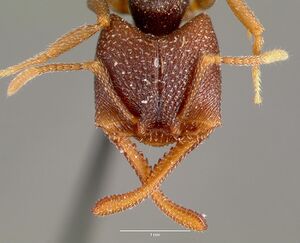 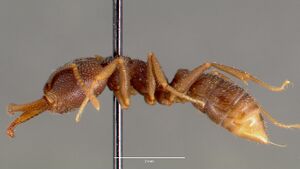  
| |
| Worker. Specimen code casent0003309. Photographer April Nobile, uploaded by California Academy of Sciences. | Owned by MCZ, Cambridge, MA, USA. |
   
| |
| Worker. Specimen code casent0003308. Photographer April Nobile, uploaded by California Academy of Sciences. | Owned by MCZ, Cambridge, MA, USA. |
   
| |
| Worker. Specimen code casent0003310. Photographer April Nobile, uploaded by California Academy of Sciences. | Owned by MCZ, Cambridge, MA, USA. |
 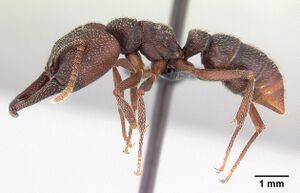  
| |
| Worker. Specimen code casent0003806. Photographer Erin Prado, uploaded by California Academy of Sciences. | Owned by CAS, San Francisco, CA, USA. |
   
| |
| Lectotype of Mystrium rogeri. Worker. Specimen code casent0101670. Photographer April Nobile, uploaded by California Academy of Sciences. | Owned by MHNG, Geneva, Switzerland. |
   
| |
| Worker. Specimen code casent0102172. Photographer April Nobile, uploaded by California Academy of Sciences. | Owned by NHMUK, London, UK. |
   
| |
| Worker. Specimen code casent0135223. Photographer Erin Prado, uploaded by California Academy of Sciences. | Owned by CAS, San Francisco, CA, USA. |
   
| |
| Queen (alate/dealate). Specimen code casent0136702. Photographer Erin Prado, uploaded by California Academy of Sciences. | Owned by CAS, San Francisco, CA, USA. |
   
| |
| Worker. Specimen code casent0172602. Photographer April Nobile, uploaded by California Academy of Sciences. | Owned by LACM, Los Angeles, CA, USA. |
   
| |
| Worker. Specimen code casent0429930. Photographer Erin Prado, uploaded by California Academy of Sciences. | Owned by CAS, San Francisco, CA, USA. |
   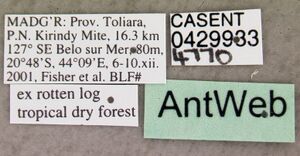
| |
| Queen (alate/dealate). Specimen code casent0429933. Photographer April Nobile, uploaded by California Academy of Sciences. | Owned by CAS, San Francisco, CA, USA. |
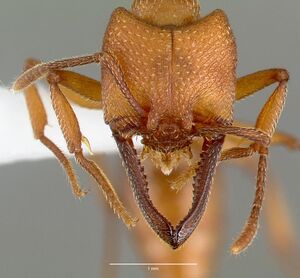 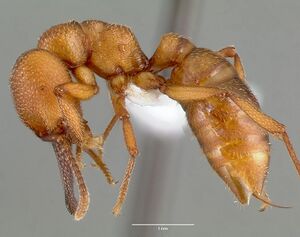  
| |
| Worker. Specimen code casent0429953. Photographer April Nobile, uploaded by California Academy of Sciences. | Owned by CAS, San Francisco, CA, USA. |
   
| |
| Worker. Specimen code casent0429955. Photographer April Nobile, uploaded by California Academy of Sciences. | Owned by CAS, San Francisco, CA, USA. |
     
| |
| Worker. Specimen code casent0009349. Photographer April Nobile, uploaded by California Academy of Sciences. | Owned by CAS, San Francisco, CA, USA. |
     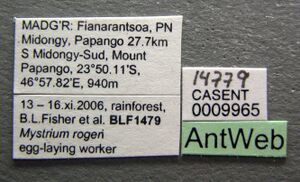
| |
| Worker. Specimen code casent0009965. Photographer April Nobile, uploaded by California Academy of Sciences. | Owned by CAS, San Francisco, CA, USA. |
 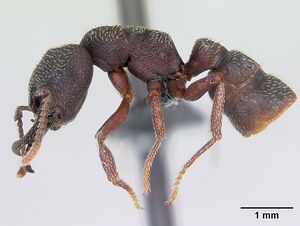    
| |
| Worker. Specimen code casent0009966. Photographer April Nobile, uploaded by California Academy of Sciences. | Owned by CAS, San Francisco, CA, USA. |
     
| |
| Worker. Specimen code casent0009967. Photographer April Nobile, uploaded by California Academy of Sciences. | Owned by CAS, San Francisco, CA, USA. |
     
| |
| Worker. Specimen code casent0009968. Photographer April Nobile, uploaded by California Academy of Sciences. | Owned by CAS, San Francisco, CA, USA. |
   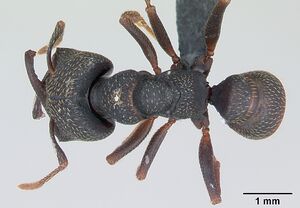  
| |
| Worker. Specimen code casent0009969. Photographer April Nobile, uploaded by California Academy of Sciences. | Owned by CAS, San Francisco, CA, USA. |
Queen
Images from AntWeb
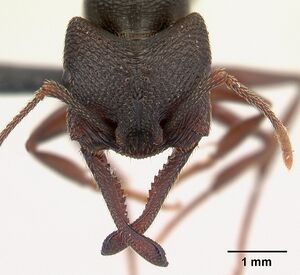    
| |
| Queen (alate/dealate). Specimen code casent0490713. Photographer Erin Prado, uploaded by California Academy of Sciences. | Owned by CAS, San Francisco, CA, USA. |
  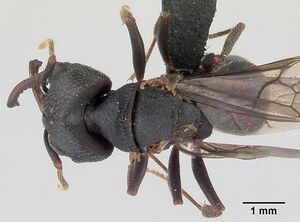 
| |
| Queen (alate/dealate). Specimen code casent0146246. Photographer Erin Prado, uploaded by California Academy of Sciences. | Owned by CAS, San Francisco, CA, USA. |
Male
Images from AntWeb
  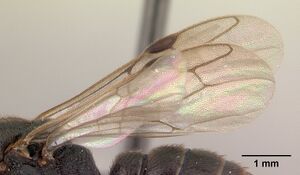   
| |
| Male (alate). Specimen code casent0007826. Photographer Erin Prado, uploaded by California Academy of Sciences. | Owned by CAS, San Francisco, CA, USA. |
     
| |
| Male (alate). Specimen code casent0147379. Photographer Erin Prado, uploaded by California Academy of Sciences. | Owned by CAS, San Francisco, CA, USA. |
Nomenclature
The following information is derived from Barry Bolton's Online Catalogue of the Ants of the World.
- rogeri. Mystrium rogeri Forel, 1899b: 304 (w.) MADAGASCAR.
- Type-material: lectotype worker (by designation of Yoshimura & Fisher, 2014: 62).
- [Note: this taxon was based on 2 workers of M. mysticum Roger, sensu Forel, 1895k: 520 (misidentification).]
- Type-locality: Madagascar: Amparafaravantsiv.
- Type-depository: MHNG.
- Menozzi, 1929d: 527 (q.m.).
- Status as species: Emery, 1911d: 23; Wheeler, W.M. 1922a: 1006; Menozzi, 1929d: 525 (redescription); Brown, 1960a: 170; Bolton, 1995b: 287; Yoshimura & Fisher, 2014: 61 (redescription).
- Distribution: Comoros, Madagascar.
Type Material
- Lectotype (designated by Yoshimura & Fisher, 2014: 61), worker, Amparafaravantsiv Moramangoufer, Madagascar, CASENT0101670, Musee d'Histoire Naturelle Genève.
Unless otherwise noted the text for the remainder of this section is reported from the publication that includes the original description.
Description
Worker
Yoshimura and Fisher (2014) - Measurements: lectotype. HL 1.87, HW 1.85, SL 1.13, ML 1.72, HD 1.24, WL 2.09, PnW 1.14, PpW 0.98, PtW 0.92, PtL 0.53, CI 98.7, SI 61.4, MI 93.3, PpI 86.5, PtI 174.6.
HL 1.19–2.27, HW 1.12–2.28, SL 0.70–1.37, ML 1.18–2.38, HD 0.83–1.47, WL 0.18–2.52, PnW 0.67–1.23, PpW 0.57–1.05, PtW 0.51–1.04, PtL 0.33–0.65, CI 93.9–101.4, SI 59.2–64.6, MI 90.9–105.7, PpI 79.3–90.1, PtI 153.1–182.6 (10 specimens measured).
Posterolateral corner of head strongly expanding posteriorly. Posterior face of vertex forming slightly blunt angle with dorsal face on median line of head, so that declivity of vertex on lateral part slightly steeper than on median part. Ventral half of vertex smooth and not sculptured. Eye small to moderately small. Anterior margin of clypeus straight or weakly concave and with small conical setae. Genal tooth of head undeveloped, but anterolateral corner of head angulate. Masticatory margin of mandible narrowly visible in full-face view, and difference in width of dorsal surface of mandible relatively small between mandibular shaft and distal portion. Second maxillary palpomere longer than third. First flagellomere (third antennal segment) as long as pedicel (second antennal segment). Shallow and fine longitudinal striae irregularly impressed on central part of pronotal dorsum, and sometimes shallowly reticulated around those striae. On lateral surface of pronotum, deep, fine longitudinal striae impressed and wide and deep punctures arranged on central horizontal line. Mesonotum differentiated from propodeum in dorsal view, length as long as that of propodeum in large individuals, shorter than propodeum in small individuals. Metanotal groove shallowly impressed, mesonotum in lateral view as high as pronotum in large individuals, higher than pronotum in small individuals. Metanotum weakly developed in largest individuals. Metapleural gland bulla developed, so that propodeal declivity in lateral view weakly convex posteriorly on ventral portion. Petiole in dorsal view moderately narrow, relatively narrower than that of M. mysticum.
Body color brown to black.
Queen
Yoshimura and Fisher (2014) - Measurements: HL 1.94–2.31, HW 1.99–2.40, SL 1.20– 1.42, ML 1.87–2.48, HD 1.29–1.51, WL 2.78–3.31, MnW 1.42–1.83, PtW 1.03– 1.32, PtL 0.61–0.78, CI 99.8–104.2, SI 58.1–62.8, MI 90.4–103.1, MnI 68.1–76.1, PtI 155.3–185.1 (10 specimens measured).
Wings usually present and well developed; but lacking in intercaste. Wing sclerites fully developed even if wings have dropped off in queen; developed to undeveloped in variable degrees in intercaste. Posterolateral corner of head strongly expanding posteriorly, expansion not differentiated from that of workers. Posterior face of vertex forming slightly blunt angle with dorsal face on median line of head, so that declivity of vertex on lateral part slightly steeper than on median part. Ventral half of vertex smooth and not sculptured. Eye well developed. Both anterior and lateral ocelli clearly present in queen; ocelli varied from absent to developed in intercaste. Anterior margin of clypeus straight or weakly concave with small conical setae. Anterolateral portion of head weakly to strongly angulate or with short spine. Masticatory margin of mandible narrowly, slightly visible in full-face view, dorsal surface on distal portion moderately wider than on mandibular shaft, difference in width much smaller than that in M. mysticum. Teeth always present on whole mandibular shaft. Spatulate seta present on basal side of each basal denticle on masticatory margin of mandible. First flagellar segment on antenna as long as pedicel. Setae on pronotum spatulate, widened distally with sharp or blunt apex. Propodeal declivity in lateral view almost straight and forming right to slightly obtuse angle with its dorsal margin, of which ventral portion with small convexity by metapleural gland. Petiole relatively long in dorsal view, about 0.6× length of abdominal segment III.
Body color black.
Male
Yoshimura and Fisher (2014) - Measurements: HL 1.10–1.41, HW 1.43–1.85, SL 0.25–0.34, EL 0.59–0.76, WL 2.27–3.03, MnW 1.46–1.96, CI 127.9–132.0, SI 16.2–20.0, EI 49.9–54.1, MnI 101.4-107.6 (6 specimens measured).
Eye relatively small, occupying about half of head length. Ocelli relatively distant from dorsal margin of head in full-face view, or just failing to reach dorsal margin. Dorsal margin of head in full-face view rounded. Both anterior and lateral ocelli small. Distance between lateral ocellus and eye long, 3× longer than diameter of lateral ocellus. Posterior half of vertex clearly differentiated from dorsal half, dorsal face almost as long as posterior face. Palpal formula 4,3. First segment of maxillary palp flattened and distinctly wider than second segment. Second maxillary palpomere longer than third. Notauli clearly impressed on mesoscutum. Petiole in dorsal view thin, its length about 0.5-0.65× that of abdominal tergite III. Petiolar dorsum covered with rough, deep punctures. Abdominal tergum VIII roughly and deeply punctured.
Abdominal sternum IX punctured on its distal portion. Basal ring short, not extending basally. Telomere extending slightly further distally than digitus. Basoventral expansion of aedeagus less developed basoventrally, as long as dorsal extension. Ventral margin of aedeagus gently curved ventrally in lateral view. Aedeagus weakly narrowing distally, its distal portion widely rounded.
On forewing, cu-a located at junction of Media (M) and Cubitus (Cu).
Body color reddish brown to black.
Type Material
Yoshimura and Fisher (2014) - Lectotype [here designated]. Worker: CASENT0101670, MADAGASCAR, Amparafaravantsiv Moramangoufer [MHNG: examined].
References
- Brown, W. L., Jr. 1960a. Contributions toward a reclassification of the Formicidae. III. Tribe Amblyoponini (Hymenoptera). Bulletin of the Museum of Comparative Zoology 122: 143-230 (see also)
- Cantone S. 2017. Winged Ants, The Male, Dichotomous key to genera of winged male ants in the World, Behavioral ecology of mating flight (self-published).
- Forel, A. 1899c. Trois notices myrmécologiques. Ann. Soc. Entomol. Belg. 43: 303-310 (page 304, worker described)
- Holldobler, B., Obermayer, M. & Alpert, G.D. 1998. Chemical trail communication in the amblyopone species Mystrium rogeri Forel (Hymenoptera, Formicidae, Ponerinae). Chemoecology. 8:119–123.
- Menozzi, C. 1929e. Revisione delle formiche del genere Mystrium Roger. Zool. Anz. 82: 518-536 (page 527, queen, male described)
- Molet M, Fisher B.L, Ito F, Peeters C 2009. Shift from independent to dependent colony foundation and evolution of ‘multi-purpose’ ergatoid queens in Mystrium ants (subfamily Amblyoponinae). Biological Journal of the Linnean Society 98: 198–207.
- Molet M, Peeters C, Fisher BL 2007a. Winged queens replaced by reproductives smaller than workers in Mystrium ants. Naturwissenschaften 94: 280–287.
- Trible, W., Kronauer, D.J.C. 2017. Caste development and evolution in ants: it's all about size. Journal of Experimental Biology 220, 53–62 (doi:10.1242/jeb.145292).
- Yoshimura, M. & Fisher, B.L. 2014. A revision of the ant genus Mystrium in the Malagasy region with description of six new species and remarks on Amblyopone and Stigmatomma (Hymenoptera, Formicidae, Amblyoponinae). ZooKeys 394, 1–99.
References based on Global Ant Biodiversity Informatics
- Blaimer B. B., S. G. Brady, T. R. Schultz, and B. L. Fisher. 2015. Fucntional and phylogenetic approaches reveal the evolution of diversity in a hyper diverse biota. Ecography 38: 001-012.
- Brown W. L., Jr. 1960. Contributions toward a reclassification of the Formicidae. III. Tribe Amblyoponini (Hymenoptera). Bulletin of the Museum of Comparative Zoology 122: 143-230.
- Emery C. 1911. Hymenoptera. Fam. Formicidae. Subfam. Ponerinae. Genera Insectorum 118: 1-125.
- Fisher B. L. 1997. Biogeography and ecology of the ant fauna of Madagascar (Hymenoptera: Formicidae). Journal of Natural History 31: 269-302.
- Fisher B. L. 2003. Formicidae, ants. Pp. 811-819 in: Goodman, S. M.; Benstead, J. P. (eds.) 2003. The natural history of Madagascar. Chicago: University of Chicago Press, xxi + 1709 pp.
- Menozzi C. 1929. Revisione delle formiche del genere Mystrium Roger. Zoologischer Anzeiger. 82: 518-536.
- Wheeler W. M. 1922. Ants of the American Museum Congo expedition. A contribution to the myrmecology of Africa. IX. A synonymic list of the ants of the Malagasy region. Bulletin of the American Museum of Natural History 45: 1005-1055
- Yoshimura M., and B. L. Fisher. 2014. A revision of the ant genus Mystrium in the Malagasy region with description of six new species and remarks on Amblyopone and Stigmatomma (Hymenoptera, Formicidae, Amblyoponinae). ZooKeys 394: 1-99.





